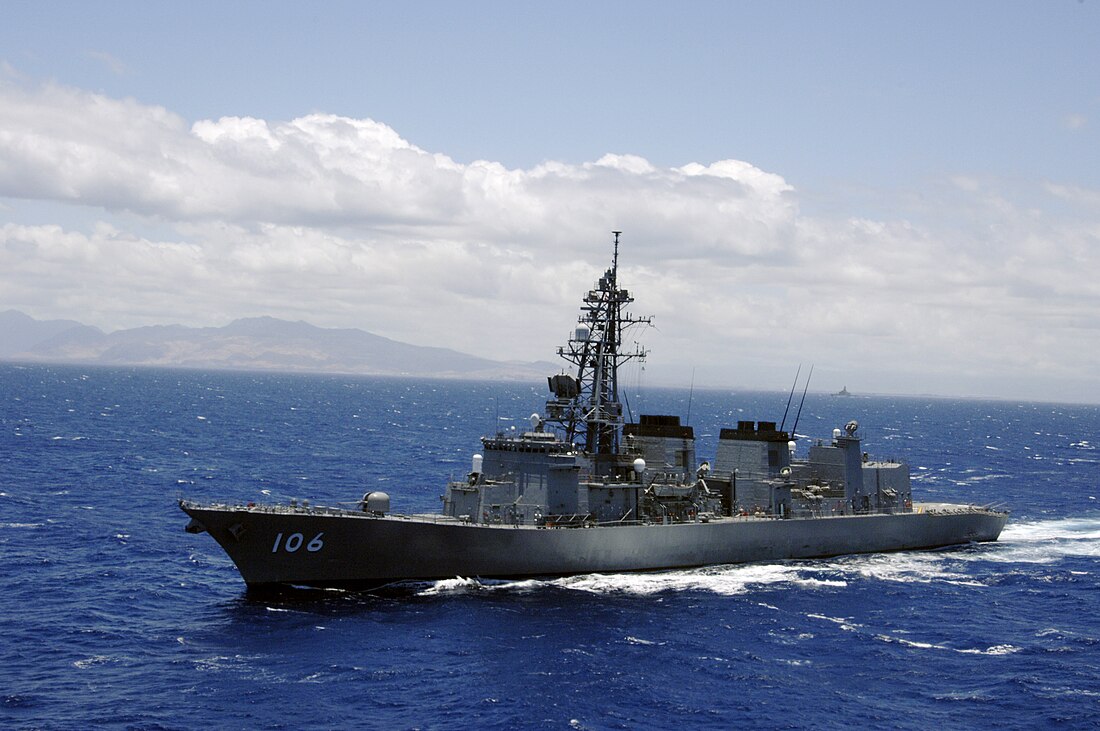Top Qs
Timeline
Chat
Perspective
Murasame-class destroyer (1994)
Destroyer class in the Japanese Maritime Self-Defense Forces From Wikipedia, the free encyclopedia
Remove ads
The Murasame-class destroyer (むらさめ型護衛艦, Murasame-gata-goei-kan) is a class of destroyers serving with the Japan Maritime Self-Defense Force (JMSDF). This is the first class of the second-generation, general-purpose destroyers of the JMSDF.[1]
Remove ads
Background
Since fiscal year 1977, the JMSDF started construction of general-purpose destroyers (汎用護衛艦, Hanyou-goei-kan) under the eight ships / eight helicopters concept.[2] In this concept, each flotilla would be composed of one helicopter destroyer (DDH), five general-purpose destroyers (DD), and two guided-missile destroyers (DDG).[3] By fiscal year 1986, construction of twenty first-generation DDs (twelve Hatsuyuki class and eight Asagiri class) required for all four flotillas had been completed.[2]
In the original plan, construction was supposed to shift to destroyer escorts, for local District Forces, afterwards. However, if the use of these first-generation DDs was continued to the full extent of the ship's lives, obsolescence was a concern. Thus the JMSDF decided to advance the construction of the new generation DDs, and this was the first class of the second-generation DDs.[1]
Except for Kirisame, all ships of the class are named after Imperial Japanese Navy destroyers in World War II.[citation needed]
Remove ads
Design
The hull design was completely renovated from first-generation DDs. In addition to increasing the size in order to reduce the underwater radiation noise, both superstructure and hull were inclined to reduce the radar cross-section. There is, however, no angled tripod mainmast like the one on the American Arleigh Burke-class destroyer because of the heavy weather of the Sea of Japan in winter. The aft was designed like a "mini-Oranda-zaka" as with the Kongō class to avoid interference between helicopters and mooring devices.[4][Note 1]
The engine arrangement is COGAG, same as the Asagiri-class, but the pair of engines are updated to Spey SM1C. The remaining one pair are replaced by LM2500, same as the Kongō-class.[4]
Remove ads
Equipment
Summarize
Perspective
The basic configuration of the equipment is the same as first-generation DDs, but they are updated and enhanced throughout. Concepts of its combat system were partly based on those of Kongō class. Two large-screen displays and OJ-663 consoles are introduced in its OYQ-9 combat direction system as Aegis Weapon System (AWS). And OYQ-103 ASW combat systems, based on OYQ-102 of Kongō class and indirectly AN/SQQ-89, present an integrated picture of the tactical situation by receiving, combining, and processing active and passive sensor data from the hull-mounted array, towed array and sonobuoys.[6]
The advanced OPS-24 active electronically scanned array radar and OPS-28 surface search and target acquisition radar introduced into the fleet with the latter batch of the Asagiri class remain on board, and there are some new systems like the NOLQ-3 electronic warfare suite and OQS-5 bow-mounted sonar.[4]
To enhance the low-observability and combat readiness capability, vertical launching systems were adopted on its missile systems: Mk 41 for VL-ASROC and Mk 48 for Sea Sparrow replace the traditional swivel octuple launchers. And the surface-to-surface missile system is alternated by the SSM-1B of Japanese make.[4] Currently, ships of this class have been switching the point defense missile system from the traditional Sea Sparrow (RIM-7M) to the Evolved Sea Sparrow by FY2012.[7]
The aircraft facility is expanded to accommodate two shipboard helicopters. One Mitsubishi SH-60J/K is a basic load, and another can be accommodated in case of overseas operation.[2]
Ships in the class
Remove ads
Gallery
- JS Murasame, JS Harusame, JS Yudachi and JS Kirisame in Pearl Harbor
- JS Harusame
- JS Inazuma
- JS Ariake
- JS Ariake
- JS Ikazuchi
- JS Ikazuchi
- Type 90 (SSM-1B) launcher of Murasame class
- 76 mm 62 cal compact gun
See also
Notes
- Destroyers built under the First Defense Build-up Plan, including the former Murasame class, adopted a unique, long-forecastle style called "Oranda-zaka".[5]
References
External links
Wikiwand - on
Seamless Wikipedia browsing. On steroids.
Remove ads










